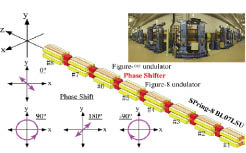Development of the Polarization Control Segmented Cross Undulator at SPring-8 BL07LSU
I. Matsuda, Harada, and Shin Groups
Synchrotron-based soft X-ray spectroscopy has proven to be a powerful experimental technique for studying the atomic, molecular and electronic structures of materials. The energy range of soft X-rays covers the K-edge absorption of the most abundant elements on Earth (e.g. C, N, O, Si) and the L-edge absorption of the industrially important transition metals (Ti, V, Cr, Mn, Fe, Co, Ni, Cu and Zn). Soft X-ray spectroscopy has many unique characteristics, such as element specificity, chemical specificity and surface sensitivity. Furthermore, responses of a matter with different light polarization determine orbitals of the electronic states in solids, configurations of molecules on a surface, and spin/orbital magnetic moments of magnetic atoms. These properties make them versatile for application in a wide range of scientific fields including surface chemistry, environmental science and magnetism. Therefore, developments of polarization control soft X-ray sources have been one of the significant issues in condensed matter physics.

Fig. 1. Schematic and photograph of a novel segmented cross undulator at SPring-8 BL07LSU that generates polarization controlled soft X-ray.
Recently, we have constructed a new soft X-ray beamline, BL07LSU, at SPring-8 to perform advanced soft X-ray spectroscopy for materials science. To realize the state-of-the-art performance, a novel segmented cross undulator (SCU) was developed and adopted as a soft X-ray light source. Figure 1 shows schematic drawing and photograph of the SCU. It consists of eight undulator segments and seven phase shifters (PS), and its total length is 27 m. Four segments generate horizontally linearly polarized radiation at the fundamental radiation (Figure-8 undulator), and the other four segments generate vertically linearly polarized radiation (Figure-∞ undulator). The horizontal and vertical undulator segments are placed alternately. Circular or tilted linearly polarized light can be obtained by superposing horizontally and vertically linearly polarized radiation, and the helicity of the circularly polarized radiation, for example, can be changed by the PSs. The PSs adjust the relative phase of the undulator radiation emitted from each segment by changing the path length of the electron orbit between segments with a local orbit bump. Linear polarization, PL, and circular polarization, PC, are evaluated by the rotating analyzer ellipsometry using the multilayer mirrors. The degrees of linear polarization (PL) from four horizontal or four vertical segments are both 1.00. The degree of circular polarization (PC) from four horizontal and four vertical segments are - 0.94 and 0.93 for left- and right-handed circularly polarized light, respectively.
The degree of polarization at SPring-8 BL07LSU is high enough to perform various soft X-ray spectroscopy using light polarization, such near-edge X-ray fine structure, X-ray magnetic circular dichroism, X-ray magneto-optical Kerr effect, and resonant soft X-ray diffraction. Moreover, the beamline optics and the experimental stations allow users to carry out the experiments also at small region (70 nm), with time resolutions (50 ps), and with high energy resolution (> 10,000).
References
- [1] S. Yamamoto, Y. Senba, T. Tanaka, H. Ohashi, T. Hirono, H. Kimura, M. Fujisawa, J. Miyawaki, A. Harasawa, T. Seike, S. Takahashi, N. Nariyama, T. Matsushita, M. Takeuchi, T. Ohata, Y. Furukawa, K. Takeshita, S. Goto, Y. Harada, S. Shin, H. Kitamura, A. Kakizaki, M. Oshima, and I. Matsuda, Journal of Synchrotron Radiation 21, 352 (2014).
